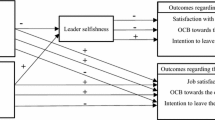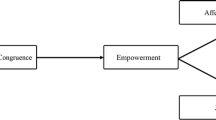Abstract
We investigate how social comparison processes in leader treatment quality impact group members’ self-worth, affect, and behavior. Evidences from the field and the laboratory suggest that employees who are treated kinder and more considerate than their fellow group members experience more self-worth and positive affect. Moreover, the greater positive self-implications of preferentially treated group members motivate them more strongly to comply with norms and to engage in tasks that benefit the group. These findings suggest that leaders face an ethical trade-off between satisfying the moral standard of treating everybody equally well and satisfying individual group members’ desire to be treated better than others.





Similar content being viewed by others
References
Allan, S., & Gilbert, P. (1995). A social comparison scale: Psychometric properties and relationship to psychopathology. Personality and Individual Differences, 19, 293–299.
Aquino, K., Lewis, M. U., & Bradfield, M. (1999). Justice constructs, negative affectivity, and employee deviance: A proposed model and empirical test. Journal of Organizational Behavior, 20, 1073–1091.
Aquino, K., & Reed, A, II (2002). The self-importance of moral identity. Journal of Personality and Social Psychology, 83, 1423–1440.
Argyle, M., & Dean, J. (1965). Eye-contact, distance and affiliation. Sociometry, 3, 289–304.
Bandura, A. (1989). Human agency in social cognitive theory. American Psychologist, 44, 1175–1184.
Baron, R. M., & Kenny, D. A. (1986). The moderator-mediator variable distinction in social psychological research: Conceptual, strategic, and statistical considerations. Journal of Personality and Social Psychology, 51, 1173–1182.
Bies, R. J. (2001). Interactional (in)justice: The sacred and the profane. In J. Greenberg & R. Cropanzano (Eds.), Advances in organizational justice (pp. 89–118). Stanford, CA: Stanford University Press.
Blader, S. L., & Tyler, T. R. (2009). Testing and extending the group engagement model: Linkages between social identity, procedural justice, economic outcomes and extra role behavior. Journal of Applied Psychology, 94, 445–464.
Colquitt, J. A. (2001). On the dimensionality of organizational justice: A construct validation of a measure. Journal of Applied Psychology, 86, 386–400.
Crocker, J., & Luthanen, R. (1990). Collective self-esteem and ingroup bias. Journal of Personality and Social Psychology, 58, 60–67.
Daniels, D., & Plomin, R. (1985). Differential experience of siblings in the same family. Developmental Psychology, 21, 747–760.
De Cremer, D. (2004). The influence of accuracy as a function of leader’s bias: The role of trustworthiness in the psychology of procedural justice. Personality and Social Psychology Bulletin, 30, 293–304.
De Cremer, D., & Tyler, T. R. (2005). Procedural justice, sense of self, and cooperation. Advances in Experimental Social Psychology, 37, 151–218.
Festinger, L. (1954). A theory of social comparison processes. Human Relations, 7, 117–140.
Fiske, S. T. (2004). Social beings: Core motives in social psychology. New York: Wiley.
Folger, R., & Cropanzano, R. (1998). Organizational justice and human resource management. London: Sage.
Frank, R. (1985). Choosing the right pond: Human behavior and the quest for status. New York: Oxford University Press.
Goethals, G. R. (1986). Social comparison theory: Psychology from the lost and found. Personality and Social Psychology Bulletin, 12, 261–278.
Hepper, E. G., & Sedikides, C. (2010). Self-enhancing feedback. In R. Sutton, M. Hornsey, & K. Douglas (Eds.), Feedback: The handbook of praise, criticism, and advice. Oxford: Peter Lang Publishing Group.
Kant, I. (1785). Grundlegung zur Metaphysik der Sitten. Berlin: Preußische Akademie der Wissenschaften.
Kelley, H. H. (1952). The two functions of reference groups. In G. E. Swanson, T. M. Newcomb, & E. E. Hartley (Eds.), Readings in social psychology (2nd ed.). New York: Holt, Rinehart, and Winston.
Kohlberg, L. (1981). The philosophy of moral development: Moral stages and the idea of justice: Volume 1. Essays on moral development. New York: Harper and Row.
MacKinnon, D. P., & Fairchild, A. J. (2009). Current directions in mediation analysis. Current Directions in Psychological Science, 18, 16–20.
Messick, D., & Sentis, K. (1979). Fairness and preference. Journal of Experimental Social Psychology, 15, 418–434.
Moorman, R. H. (1991). Relationship between organizational justice and organizational citizenship behaviors: Do fairness perceptions influence employee citizenship? Journal of Applied Psychology, 76, 845–855.
Mussweiler, T. (2003). Comparison processes in social judgment: Mechanisms and consequences. Psychological Review, 110, 472–489.
Pierce, J. L., Gardner, D. G., Cummings, L. L., & Dunham, R. B. (1989). Organizational-based self esteem: Construct definition and measurement. Academy of Management Journal, 52, 622–648.
Rawls, J. (1971). A theory of justice. New York: Oxford University Press.
Shrout, P. E., & Bolger, N. (2002). Mediation in experimental and nonexperimental studies: New procedures and recommendations. Psychological Methods, 7, 422–445.
Simon, B., & Stürmer, S. (2003). Respect for group members: Intragroup determinants of collective identification and group-serving behavior. Personality and Social Psychology Bulletin, 29, 183–193.
Smith, H. J., Tyler, T. R., Huo, Y. J., Ortiz, D. J., & Lind, E. A. (1998). The self-relevant implications of the group-value model: Group membership, self-worth, and treatment quality. Journal of Experimental Social Psychology, 34, 470–493.
Snijders, T. A. B., & Bosker, R. J. (1999). Multilevel analysis: An introduction to basic and advanced multilevel modeling. London: Sage.
Stevens, L. E., & Fiske, S. T. (1995). Motivation and cognition in social life: A social survival perspective. Social Cognition, 13, 189–214.
Thau, S., Aquino, K., & Wittek, R. (2007). An extension of uncertainty management theory to the self: The relationship between justice, social comparison orientation, and antisocial work behaviors. Journal of Applied Psychology, 92, 250–258.
Tyler, T. R. (1989). The psychology of procedural justice: A test of the group value model. Journal of Personality and Social Psychology, 57, 830–838.
Tyler, T. R. (1994). Psychological models of the justice motive. Journal of Personality and Social Psychology, 67, 850–863.
Tyler, T. R. (1999). Why people cooperate with organizations: An identity-based perspective. In B. Staw & R. Sutton (Eds.), Research in organizational behavior (pp. 201–246). Greenwich, CT: JAI Press.
Tyler, T. R., & Blader, S. L. (2002). Autonomous vs. comparative status: Must we be better than others to feel good about ourselves? Organizational Behavior and Human Decision Processes, 89, 813–838.
Tyler, T. R., & Blader, S. L. (2003). The group engagement model: Procedural justice, social identity, and cooperative behavior. Personality and Social Psychology Review, 7, 349–361.
Tyler, T. R., & Lind, E. A. (1992). A relational model of authority in groups. In M. Zanna (Ed.), Advances in experimental social psychology (Vol. 25, pp. 115–191). New York: Academic Press.
Vlastos, G. (1962). Justice and equality. In R. Brandt (Ed.), Social justice (pp. 31–72). Englewood Cliffs: Prentice-Hall.
Watson, D., Clark, L. A., & Tellegen, A. (1988). Development and validation of brief measures of positive and negative affect: The PANAS scales. Journal of Personality and Social Psychology, 54, 1063–1070.
Author information
Authors and Affiliations
Corresponding author
Additional information
Stefan Thau, Christian Tröster contributed equally to this paper. This research was supported by a London Business School RAMD grant to the first author.
Rights and permissions
About this article
Cite this article
Thau, S., Tröster, C., Aquino, K. et al. Satisfying Individual Desires or Moral Standards? Preferential Treatment and Group Members’ Self-Worth, Affect, and Behavior. J Bus Ethics 113, 133–145 (2013). https://doi.org/10.1007/s10551-012-1287-5
Received:
Accepted:
Published:
Issue Date:
DOI: https://doi.org/10.1007/s10551-012-1287-5




